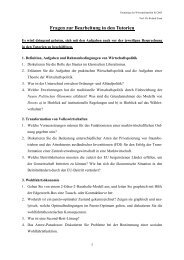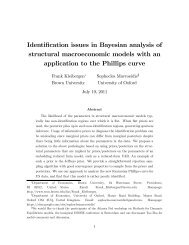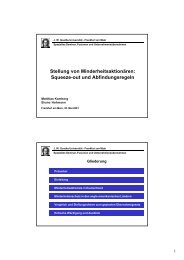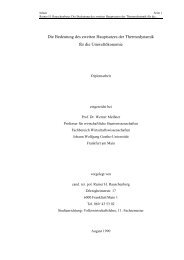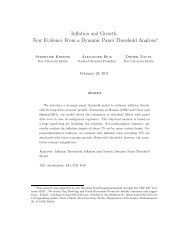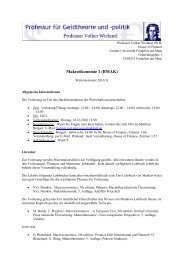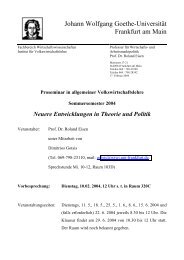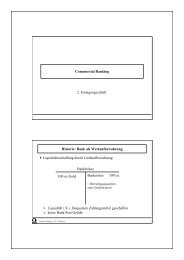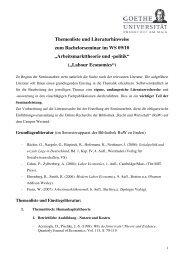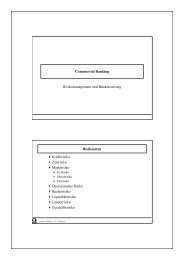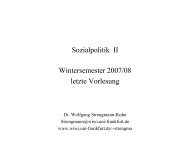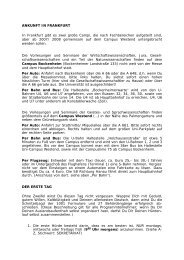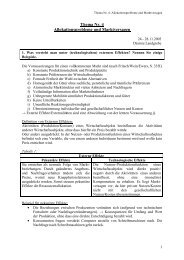Calvo vs. Rotemberg in a Trend Inflation World - Wiwi Uni-Frankfurt
Calvo vs. Rotemberg in a Trend Inflation World - Wiwi Uni-Frankfurt
Calvo vs. Rotemberg in a Trend Inflation World - Wiwi Uni-Frankfurt
You also want an ePaper? Increase the reach of your titles
YUMPU automatically turns print PDFs into web optimized ePapers that Google loves.
models, which are log-l<strong>in</strong>earized around a general trend <strong>in</strong>‡ation level, can treat trend<br />
<strong>in</strong>‡ation <strong>in</strong> a model consistent way. This consideration is important when search<strong>in</strong>g<br />
for the encompassed "basel<strong>in</strong>e New-Keynesian model". Indeed, an obvious way to<br />
collapse to such model would be that of sett<strong>in</strong>g the gross trend <strong>in</strong>‡ation rate = 1, so<br />
reconstruct<strong>in</strong>g the "zero-steady state" assumption typically employed <strong>in</strong> the literature<br />
when deriv<strong>in</strong>g such model. However, eq. (21) makes it clear that, while be<strong>in</strong>g logically<br />
grounded, this choice would force us to leave the mean of observed <strong>in</strong>‡ation unmodeled,<br />
so condemn<strong>in</strong>g the standard New-Keynesian model to a poor empirical performance. To<br />
circumvent this issue, one could demean observed <strong>in</strong>‡ation prior to estimation. However,<br />
this would probably penalize, <strong>in</strong> relative terms, the trend <strong>in</strong>‡ation models, one of their<br />
edges be<strong>in</strong>g their ability to model the …rst moment of observed <strong>in</strong>‡ation. To estimate<br />
the encompassed basel<strong>in</strong>e, "zero trend <strong>in</strong>‡ation" framework, we then set the <strong>in</strong>dexation<br />
parameter = 1; as <strong>in</strong> Christiano et al. (2005). In do<strong>in</strong>g so, we switch o¤ the trend<br />
<strong>in</strong>‡ation-related "extra terms", and we mute the impact of trend <strong>in</strong>‡ation on the relative<br />
weights of <strong>in</strong>‡ation expectations and marg<strong>in</strong>al costs <strong>in</strong> the NKPC and IS schedules. We<br />
can then assign a positive trend <strong>in</strong>‡ation rate (with which we model the <strong>in</strong>‡ation mean)<br />
to the basel<strong>in</strong>e New-Keynesian model <strong>in</strong> a theoretically-consistent manner.<br />
Our dogmatic priors and prior densities read as follows. We assume standard values<br />
for a sub-set of parameters, i.e. we set the discount factor to 0:99, the elasticity of<br />
substitution among goods " = 6, and the <strong>in</strong>verse of the labor elasticity ' to 1. To<br />
favor a smooth convergence towards the ergodic distribution, we …x the relative degree<br />
of <strong>in</strong>dexation to 1, i.e., we concentrate on <strong>in</strong>dexation to past <strong>in</strong>‡ation, <strong>in</strong> l<strong>in</strong>e with<br />
Benati (2009). We calibrate the steady state <strong>in</strong>‡ation rate by appeal<strong>in</strong>g to <strong>in</strong>‡ation’s<br />
sample mean, i.e., = 1:0063, which translates to a net annual <strong>in</strong>‡ation target of<br />
about 2:5%. 13 , and set y = 0:0012 and = 0:0131 (sample means of the correspond<strong>in</strong>g<br />
13 We conducted a battery of econometric exercises <strong>in</strong> which we estimated also the trend <strong>in</strong>‡ation<br />
rate. Our results turned out to be virtually unchanged.<br />
17



